Digital Posters
RF Pulses
ISMRM & SMRT Annual Meeting • 15-20 May 2021

| Concurrent 1 | 17:00 - 18:00 |
 |
3947.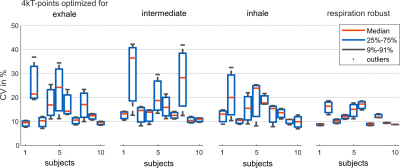 |
Respiration induced B1+ changes and its compensation via respiration robust 3D kT point pulses in 7T body imaging
Christoph Stefan Aigner1, Sebastian Dietrich1, Tobias Schaeffter1,2, and Sebastian Schmitter1,3
1Physikalisch-Technische Bundesanstalt (PTB), Braunschweig and Berlin, Germany, 2Division of Imaging Sciences and Biomedical Engineering, King's College London, London, United Kingdom, 3Medical Physics in Radiology, German Cancer Research Center (DKFZ), Heidelberg, Germany
We demonstrate the design and application of respiration-specific and respiration-robust three-dimensional 4kT-point pTx pulses using respiration-resolved 3D B1+ maps. The subject-specific pulses were tested on 20 B1+ maps (shallow/deep breathing) of 10 volunteers with different age and BMI and were experimentally validated in the last three volunteers at 7T. Compared to respiration-specific pulses, respiration-robust pulses resulted in a negligible overall decrease of the FA homogeneity with clear benefits of achieving homogeneous 3D FA across all respiration states.
|
||
3948.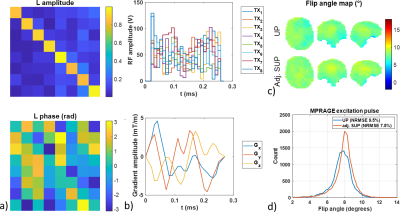 |
Reducing inter-subject variability and improving accuracy of Universal Pulses using standardized (universal) pulses
Caroline Le Ster1, Franck Mauconduit1, Aurélien Massire2, Vincent Gras1, and Nicolas Boulant1
1Paris-Saclay University, CEA, CNRS, BAOBAB, NeuroSpin, Gif-sur-Yvette, France, 2Siemens Healthcare SAS, Saint-Denis, France
Parallel transmission allows flip angle homogenization at ultra-high field. The pulse design process can be made transparent to the user with calibration-free universal pulses (UP) that are designed over a database of field maps. Here a new method is proposed where UPs are designed over a standardized database, i.e. normalized to a reference. During a scan, these standardized UPs (SUPs) are adjusted to the subject through a fast calibration that relies on a linear transformation of the actual B1+ map to the database reference. Adjusted SUPs improve excitation performance and reduce intersubject variability compared to UPs.
|
|||
3949. |
“Universal” non-selective pulse design at 7 Tesla using a birdcage coil and a B0 shim array: Evaluation of kT-points and fully optimized pulses
Bastien Guerin1, Eugene Milshteyn1, Yulin Chang2, Mads S Vinding3, Mathias Davids1, Wald L Lawrence1, and Jason Stockmann1
1Massachusetts General Hospital, Charlestown, MA, United States, 2Siemens Medical Solutions, Malvern, PA, United States, 3Center for functionally integrative neuroscience, Aarhus, Denmark
We design “universal” kT-point and fully optimized pulses for flip-angle uniformization in the brain at 7 Tesla using a birdcage coil and a B0 shim array coil. The fully optimized pulses are RF + gradient and RF + gradient + shim current waveforms joint optimization with system constraints (amplitude, slew-rate and acceleration). We design the universal pulses using 3 subjects’ field maps and evaluate them on 4 additional subjects.
|
|||
3950.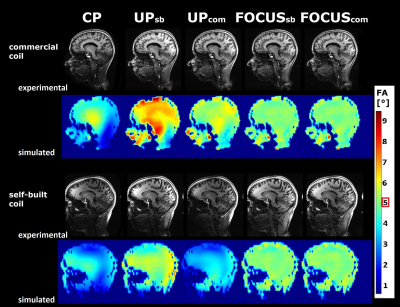 |
Evaluating Universal and Fast Online Customized Pulses for parallel transmission using two different RF coils
Jürgen Herrler1, Sydney Nicole Williams2, Patrick Liebig3, Shajan Gunamony4,5, Christian Meixner6, Andreas Maier7, Arnd Dörfler1, David Porter2, and Armin Michael Nagel6
1Institue of Neuroradiology, University Hospital Erlangen, Erlangen, Germany, 2Imaging Centre of Excellence, University of Glasgow, Glasgow, Scotland, 3SIEMENS Healthineers, Erlangen, Germany, 4Institute of Neuroscience & Psychology, University of Glasgow, Glasgow, Scotland, 5MR CoilTech Limited, Glasgow, Scotland, 6Institue of Radiology, University Hospital Erlangen, Erlangen, Germany, 7Friedrich Alexander University Erlangen Nürnberg, Erlangen, Germany
To investigate the universality of using pre-optimized parallel-transmit (pTx) pulses with different RF coils for routine imaging, Universal Pulses and Fast Online Customized Pulses were generated using eight respective datasets from both a commercial and a self-built 8Tx/32Rx coil. The pTx pulse types were designed for both excitation and inversion pulses in a 3D MPRAGE sequence. For each coil, one subject was examined with all combinations of pTx pulses. All pTx pulses outperform CP pulses on the coil they were trained on. When using a different coil, Universal Pulses may fail, especially for inversion, whereas FOCUS pulses achieve robust homogeneity.
|
|||
3951.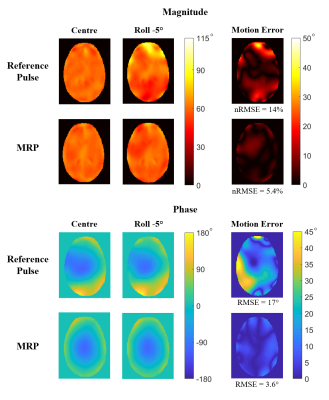 |
Motion Robust Parallel Transmission Excitation Pulse Design for Ultra-High Field MRI
Luke Watkins1, Alix Plumley2, Kevin Murphy1, and Emre Kopanoglu2
1Department of Physics and Astronomy, CUBRIC, Cardiff University, Cardiff, United Kingdom, 2Department of Psychology, CUBRIC, Cardiff University, Cardiff, United Kingdom
Within-scan patient motion reduces PTx pulse performance. A motion-robust PTx 5-spoke pulse (MRP) was designed using simulated B1 maps at multiple head positions, and was compared to a conventional 3-spoke reference pulse. For a 5° rotated head orientation, magnitude nRMSE was reduced from 14% to 5.4%, phase RMSE from 17° to 3.6°, maximum magnitude and phase errors from 64% to 20% and 68° to 15° respectively. Although a longer pulse duration, the MRP maintained similar magnitude nRMSE to the reference pulse at the centre, and superior performance in 97% of all four error metrics for 46 off-centre positions.
|
|||
3952.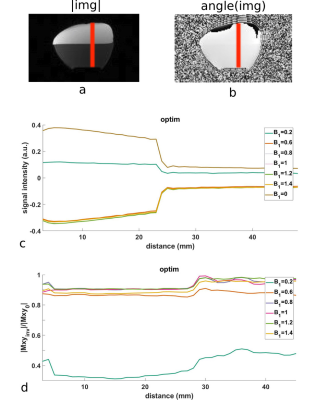 |
Time optimal control based design of robust inversion pulses
Christina Graf1, Martin Soellradl1, Armin Rund2, Christoph Stefan Aigner3, and Rudolf Stollberger1
1Graz University of Technology, Institute of Medical Engineering, Graz, Austria, 2Institute of Mathematics and Scientific Computing, University of Graz, Graz, Austria, 3Physikalisch-Technische Bundesanstalt (PTB), Braunschweig and Berlin, Berlin, Germany
The aim of this work is to design short and B0- and B1-robust inversion pulses by optimal control. A time-optimal control framework is used that incorporates variations within B0- and B1-fields. The optimized RF pulse is compared numerically to two hyperbolic-secant pulses and shows a very good efficiency over a broad set of B0-offsets and B1-scalings. Two phantom measurements are performed on a 3T MRI system for various scalings of B1 that verify the results, one with a cylindrical MRI phantom, the other one with oil and water with a contrast agent, demonstrating also the B0-robustness of the proposed pulse.
|
|||
3953.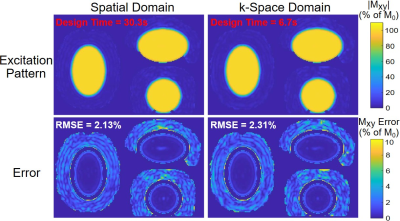 |
3D k-Space Domain Parallel Transmit Pulse Design
Jun Ma1,2, Bernhard Gruber3,4, Xinqiang Yan5, and William Grissom2
1Department of Radiology, Stanford University, Stanford, CA, United States, 2Department of Biomedical Engineering, Vanderbilt University, Nashville, TN, United States, 3A. A. Martinos Center for Biomedical Imaging, Massachusetts General Hospital, Harvard Medical School, Charlestown, MA, United States, 4Division MR Physics, Center for Medical Physics and Biomedical Engineering, Medical University Vienna, Vienna, Austria, 5Department of Radiology and Radiological Sciences, Vanderbilt University, Nashville, TN, United States
Current parallel transmit pulse design is based on a spatial domain formulation that has prohibitive memory and computational requirements when the number of coils or the number of dimensions is large. We previously introduced a k-space domain method that produces a sparse matrix relating any target excitation pattern in k-space to the pulses that produce it, which can be finely parallelized, has much smaller memory footprint, and can compensate off-resonance. Here we validate the algorithm for 3D inner-volume excitation using a simulated 24-channel transmit array and a SPINS trajectory, with comparisons to conventional iterative spatial domain designs.
|
|||
3954.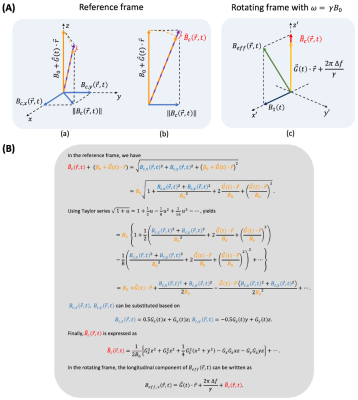 |
Multidimensional RF Pulse Design with Known Spatial Encoding Imperfections
Ziwei Zhao1, Nam G. Lee2, and Krishna S. Nayak1,2
1Ming Hsieh Department of Electrical and Computer Engineering, Viterbi School of Engineering, University of Southern California, Los Angeles, CA, United States, 2Department of Biomedical Engineering, Viterbi School of Engineering, University of Southern California, Los Angeles, CA, United States
We describe a multidimensional small-tip RF pulse design procedure that incorporates concomitant field effects and gradient imperfections. Nonrotating concomitant fields in the reference frame are modeled as a Bloch-Siegert shift in the rotating frame and treated as higher-order phase terms in the excitation k-space formalism. We evaluate the effects of concomitant fields using simulations that mimic current 0.55T, 1.5T, 3T, and 7T systems. The proposed procedure produces more accurate excitation patterns, especially when concomitant field effects are strongest, i.e., low field strengths, off-isocenter, and longer pulse durations.
|
|||
3955.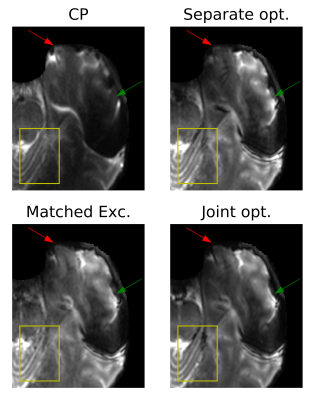 |
Joint optimisation of parallel transmission in 2D spin-echo based sequences
Belinda Ding1, Iulius Dragonu2, Patrick Liebig3, and Christopher T Rodgers1
1Wolfson Brain Imaging Centre, University of Cambridge, Cambridge, United Kingdom, 2Siemens Healthcare Limited, Firmley, United Kingdom, 3Siemens Healthineers, Erlangen, Germany
In this study, we assessed the performance of jointly optimised pTx excitation and refocusing pulses in 2D spin-echo based sequences on a 7T Terra scanner. In conventional pTx acquisitions, the excitation and refocusing pulses are designed independently based a set of fieldmaps. Here, we compared two approaches for jointly optimising the excitation and refocussing against an approach of separately optimised pTx pulses and the traditional circularly polarised pulses. We observed that pTx pulses significantly improve image quality in both phantom and in vivo acquisitions at 7T. The image quality is further improved with joint optimisation of excitation and refocusing pulses.
|
|||
3956.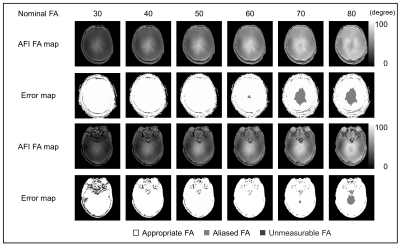 |
Optimization of the Nominal Flip Angle in Actual Flip Angle Imaging Using Phase Difference Information
Tsuyoshi Matsuda1, Ikuko Uwano1, Yuji Iwadate2, and Makoto Sasaki1
1Division of Ultrahigh Field MRI, Institute for Biomedical Sciences, Iwate Medical University, Iwate, Japan, 2Global MR Applications and Workflow, GE Healthcare Japan, Hino, Japan
Flip angles (FAs) might be underestimated during the actual FA imaging (AFI) method due to the aliasing phenomenon that occurs when the actual FAs exceeds 90°. To optimize nominal FA values for the AFI scan performed at 7 T, at which in-plane FA values markedly vary, we attempted to detect pixels showing erroneous FAs by comparing the phase difference between two types of AFI source images. AFI-FA maps with nominal FAs of ≥ 60° include substantial areas with FA underestimation, which is unsuitable for accurate FA measurements.
|
|||
3957.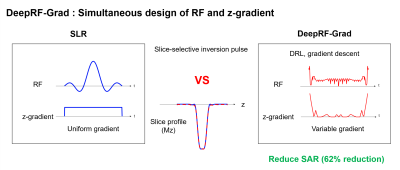 |
DeepRF-Grad: Simultaneous design of RF pulse and slice selective gradient using self-learning machine
Jiye Kim1, Dongmyung Shin1, Juhyung Park1, Hwihun Jeong1, and Jongho Lee1
1Department of Electrical and Computer Engineering, Seoul National University, Seoul, Korea, Republic of
A deep reinforcement learning method referred to as DeepRF-Grad, is newly developed to design an RF pulse and a slice selective gradient waveform. The method is demonstrated for slice-selective inversion and compared with SLR and VERSE-designed pulses. The DeepRF-Grad designed pulse showed lower SAR (SLR: 13.2mG2s, VERSE: 6.37mG2s, DeepRF-Grad: 5.00mG2s). When designed for off-resonance robustness, the DeepRF-Grad generated enhanced off-resonance characteristics compared to that of VERSE-designed pulse, while showing similar SAR.
|
|||
3958.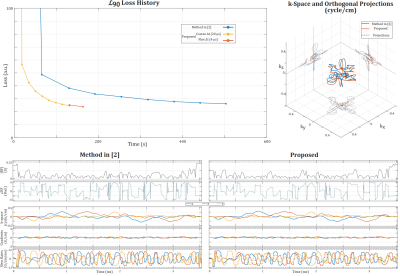 |
Multi-scale Accelerated Auto-differentiable Bloch-simulation based joint design of excitation RF and gradient waveforms.
Tianrui Luo1, Douglas C. Noll1, Jeffrey A. Fessler1, and Jon-Fredrik Nielsen1
1University of Michigan, Ann Arbor, MI, United States
A recently proposed auto-differentiable Bloch simulation approach allows joint design of RF and gradient waveforms for large-tip objectives. However, that approach requires a relatively long design time, preventing online pulse design. As a refinement, we propose to accelerate such simulation-based pulse design approaches by dividing it into two stages: 1) fast coarse dwell time design; 2) fine dwell time tuning. This combination substantially reduced the design time (from 8.5 min to 3 min), while still attaining high excitation accuracy, enabling online pulse design applications.
|
|||
3959.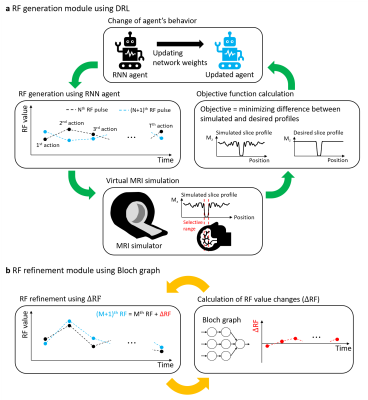 |
Consistency, ablation, and scalability studies of DeepRF
Dongmyung Shin1, Jiye Kim1, Juhyung Park1, and Jongho Lee1
1Electrical and Computer Engineering, Seoul National University, Seoul, Korea, Republic of
A recently developed RF pulse design method, DeepRF, is investigated using consistency, ablation, and scalability studies. The consistency of DeepRF designs is confirmed by repeating the same slice-selective inversion pulse design. The importance of the combination of two modules in DeepRF (i.e., RF generation and RF refinement) is verified through the ablation of each module. The scalability of DeepRF for a range of a design parameter is validated by designing several slice-selective inversion pulses with different time-bandwidth products.
|
|||
3960.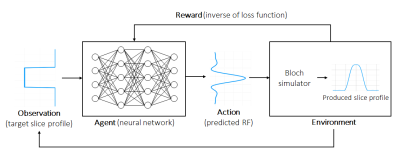 |
Exploring RF pulse design with deep reinforcement learning
Xiaodong Ma1, Kamil Uğurbil1, and Xiaoping Wu1
1Center for Magnetic Resonance Research, Radiology, Medical School, University of Minnesota, Minneapolis, MN, United States
In this study, we expand the application of a deep reinforcement learning (DRL) pulse design framework to designing four basic types of RF pulses and more complicated multi-band RF pulses. Our results showed that the DRL framework can be used to effectively design all types of RF pulses, improving slice profiles with reduced ripple levels in comparison to the conventional SLR algorithm.
|
|||
3961.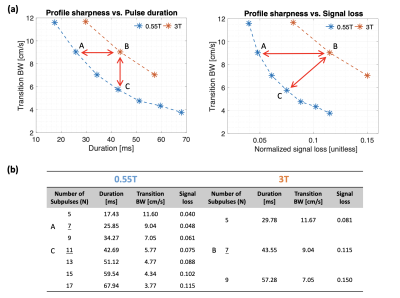 |
RF Pulse Designs for Velocity-Selective MRA at Low Field Strengths
Ziwei Zhao1, Nam G. Lee2, and Krishna S. Nayak1,2
1Ming Hsieh Department of Electrical and Computer Engineering, Viterbi School of Engineering, University of Southern California, Los Angeles, CA, United States, 2Department of Biomedical Engineering, Viterbi School of Engineering, University of Southern California, Los Angeles, CA, United States
Velocity‐selective (VS) RF pulses can differentiate flowing blood from background tissue, and have been utilized for non-contrast intracranial, abdominal, and peripheral angiography at 3T. Here, we explore RF pulse designs for intracranial VS-MRA at low field strengths including 0.55T. We evaluate pulse performance using simulations that incorporate realistic levels of B0 variation, B1+ variation, and gradient distortions. Compared to 3T, simulations indicate 22% - 38% sharper velocity transitions and/or 50% - 60% less signal loss at 0.55T. We also show that gradient distortions can lead to “stripe” artifacts and can be mitigated with pre-emphasis.
|
|||
3962.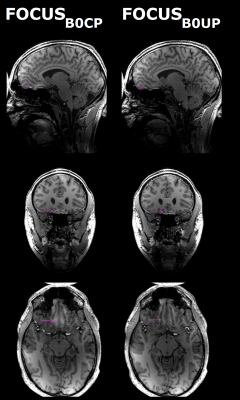 |
Improved B0 mapping with universal parallel transmit pulses at 7 tesla
Jürgen Herrler1, Patrick Liebig2, Rene Gumbrecht2, Sydney Nicole Williams3, Christian Meixner4, Andreas Maier5, Arnd Dörfler1, and Armin Michael Nagel4
1Institue of Neuroradiology, University Hospital Erlangen, Erlangen, Germany, 2SIEMENS Healthineers, Erlangen, Germany, 3Imaging Centre of Excellence, University of Glasgow, Glasgow, Scotland, 4Institue of Radiology, University Hospital Erlangen, Erlangen, Germany, 5Friedrich Alexander University Erlangen Nürnberg, Erlangen, Germany B0 mapping was performed with a circularly polarized pulse and with a non-selective universal parallel transmit (pTx) pulse. The pTx pulse showed improved homogeneity, which resulted in different B0 values, mainly present at tissue interfaces. Based on the two resulting B0 maps, patient specific B0 shimming was performed. Further, based on the two shimmed B0 maps, individually optimized pTx excitation and inversion pulses were designed for use in a 3D MPRAGE sequence. The pTx inversion pulse based on the B0 map, which itself used universal pTx pulse, achieved a reduction of B0 related artifacts in the frontal sinus region. |
|||
3963.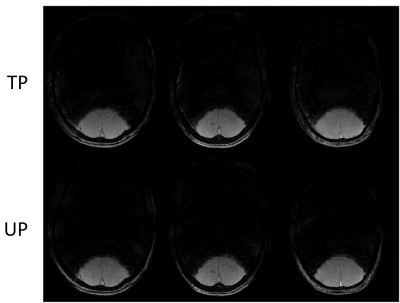 |
Universal parallel transmit pulses for a 2-dimensional local excitation target pattern at 9.4T
Ole Geldschläger1, Dario Bosch1,2, and Anke Henning1,3
1High-field Magnetic Resonance, Max-Planck-Institute for biological Cybernetics, Tübingen, Germany, 2Biomedical Magnetic Resonance, University Hospital Tübingen, Tübingen, Germany, 3Advanced Imaging Research Center, University of Texas Southwestern Medical Center, Dallas, TX, United States In this study, the concept of ‘Universal pTx pulses’ for local excitation is tested in vivo at 9.4T. Based on B0/B1+ maps from eight different subject heads, universal pulses for a 2-dimensional local excitation target pattern were designed. The pulses aiming to excite the visual cortex of the human brain (with a flip angle of 90 and 7 degree, respectively), while the remaining areas should experience no effective excitation. In simulations and in vivo at 9.4T, the resulting universal pules perform just slightly worse compared to the subject specific tailored pulses (on non-database heads). |
|||
3964.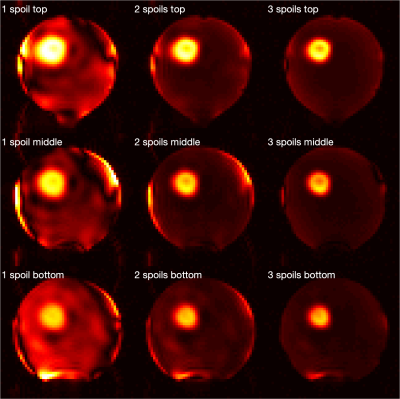 |
Spatial localisation for mapping regional oxygen extraction fraction using parallel transmission saturation pulses at 7 T
Yan Tong1, Peter Jezzard1, Caitlin O'Brien1,2, and William T Clarke1
1Wellcome Centre for Integrative Neuroimaging, FMRIB Division, NDCN, University of Oxford, Oxford, United Kingdom, 2Guy's and St Thomas' NHS Foundation Trust, London, United Kingdom
T2‐relaxation under‐spin‐tagging (TRUST) is a robust spin tagging-based method to quantify oxygen extraction fraction (OEF), but it lacks spatial specificity. Recently, O’Brien et al. proposed a method at 3 T involving multiple saturation pulses to achieve spatial specificity. Parallel transmission (pTx) provides additional degrees of freedom for spatial localisation. A pTx RF pulse design strategy based on a shells trajectory was applied to perform regional OEF measurement at 7 T. Phantom experiments showed that repeating the RF pulses significantly improved the saturation efficiency.
|
The International Society for Magnetic Resonance in Medicine is accredited by the Accreditation Council for Continuing Medical Education to provide continuing medical education for physicians.